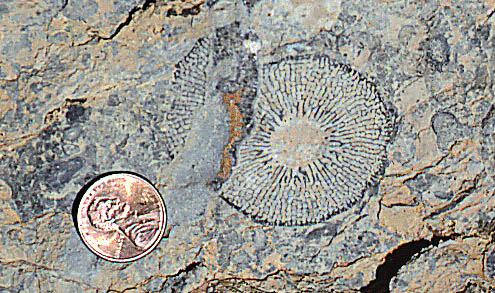Archaeocyatha

Archaeocyaths are an extinct group of
sponges that had a
very brief (geologically speaking) and spectacular history.
The first archaeocyaths appear roughly 530 million years
ago, during the Lower
Cambrian.
Archaeocyath species were very important members
of Lower Cambrian communities. They diversified into hundreds of
species during this time period and some of these species contributed
greatly to the creation of the first reefs. Reef ecosystems tend to support
a wide variety of organisms both in the present and in the past.
Despite their great success in terms of numbers, the archaeocyaths
were a short-lived group. They were almost completely non-existent
by the middle Cambrian, some 10 to 15 million years after their first appearance.
Click on the buttons below to learn more about Archaeocyatha.





Sources:
Debrenne, F., A. Rozanov and A. Zhuravlev. 1990. Regular Archaeocyaths: Morpholggy, Ontogeny, Systematics, Biostratigraphy, Paleoecolgy, CNRS Editions, Paris. 218 p. + pl. XXXII.
Debrenne, F. and J. Vacelet. 1984. Archaeocyatha: Is the sponge model consistent with their structural organization? Palaeontographica Americana, 54: 358-369
Debrenne, F. and A. Zhuravlev. 1992. Irregular Archaeocyaths: Morpholggy, Ontogeny, Systematics, Biostratigraphy, Paleoecolgy, CNRS Editions, Paris. 212 p.+ pl. I-XXXVIII.
Debrenne, F. and A. Zhuravlev. 1996. Archaeocyatha, palaeoecology: a Cambrian sessile fauna. In A. Cherchi (ed.), Autecology of Selected Fossil Organisms: Achievements and Problems. Pp. 77-85. Boll. Soc. Paleont. Ital., Modena.
Kruse, P. D. 1990. Are archaeocyaths sponges, or are sponges archaeocyaths? Geological Society of Australia Special Publication, 16: 311-323.
Rowland, S. M. and R. A. Gangloff. 1988. Structure and Paleoecology of Lower Cambrian Reefs. Palaios, 3: 111-135.
Savarese, M. 1992. Functional analysis of archaeocyathan skeletal morphology and its paleobiological implications. Paleobiology 18(4): 464-480.






